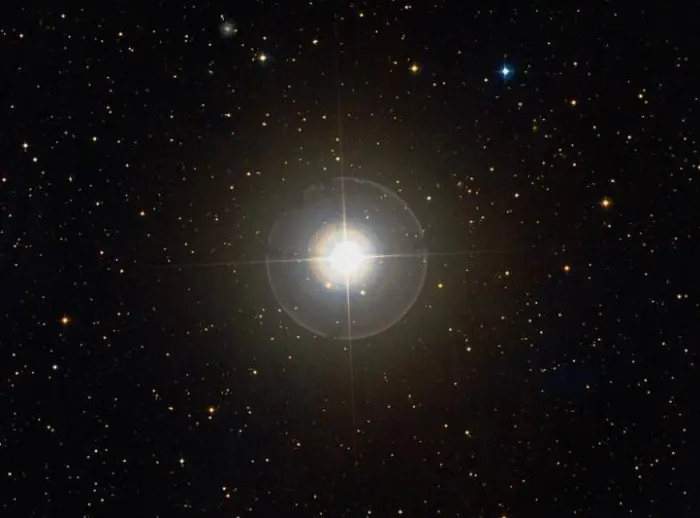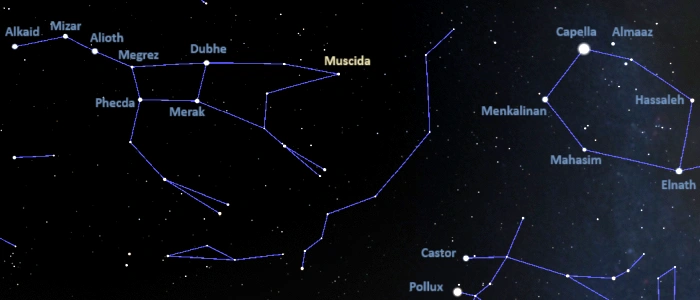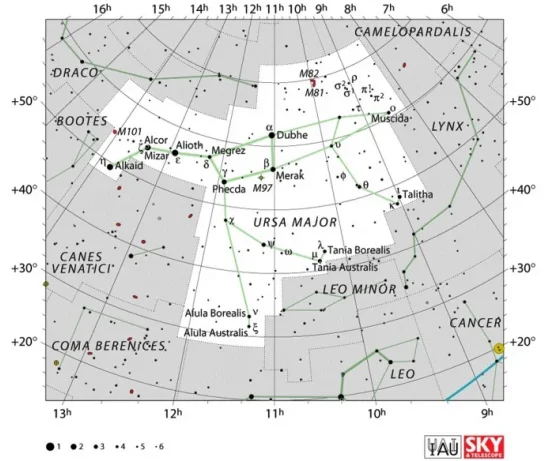Muscida, Omicron Ursae Majoris (ο UMa), is a yellow giant star located 182 light years away in the constellation Ursa Major (the Great Bear). With an apparent magnitude of 3.35, it is visible to the unaided eye. The star marks the Great Bear’s nose. It hosts an exoplanet, Omicron Ursae Majoris Ab, discovered in 2012.
Star system
Omicron Ursae Majoris is a binary star system consisting of a yellow giant star of the spectral type G5 III and a red dwarf with the stellar classification M1 V.
Muscida, Omicron Ursae Majoris A, is the primary component in the system. It has 2.72 times the Sun’s mass and a radius 13.84 times that of the Sun. With an effective temperature of 5,242 K, it is 116 times more luminous than the Sun. The star spins at 3.83 kn/s. It has an estimated age of around 360 million years.
Muscida started its life as a hot blue main sequence star of the spectral type B. As it evolved away from the main sequence, it expanded and cooled. The star will evolve into a red giant before expelling its outer layers and gradually fading as a white dwarf.
Muscida has a faint companion, the red dwarf Omicron Ursae Majoris B (M1 V), at a separation of 7.1 arcseconds. The companion has an apparent magnitude of 15.2 and is well below unaided eye visibility. It is the most likely source of the X-ray emission detected from the system. It shares a common proper motion with Muscida.
Two other visual companions appear in the same line of sight, but these stars have been found to be only optical companions.

Muscida (Omicron Ursae Majoris), image credit: ESO/Digitized Sky Survey 2 (CC BY 4.0)
Planet
Muscida has an orbiting extrasolar planet, Omicron Ursae Majoris Ab. The gas giant was discovered by a team of astronomers led by Bun’ei Sato at the Okayama Astrophysical Observatory (OAO), National Astronomical Observatory of Japan, in 2012. The planet has a mass 4.1 times that of Jupiter and takes 1,630 days to complete an orbit around the parent star. It orbits at a distance of 3.9 astronomical units (AU).
Omicron Ursae Majoris Ab was discovered with the HIgh Dispersion Echelle Spectrograph (HIDES) at the Okayama Astrophysical Observatory on top of Mt. Chikurinji in Okayama. At the time of discovery, it was the first candidate planet found orbiting a star with a mass of over 3 solar masses.
Facts
Muscida is the 12th brightest star in the constellation Ursa Major. It is only imperceptibly fainter than Megrez (Delta Ursae Majoris), the faintest star of the Big Dipper.
Muscida is a member of the Milky Way’s thin disk population. It orbits through the Milky Way with an eccentricity of 0.12, coming with 23,500 light-years of the Galactic centre and getting as far away as 30,200 light-years.
Omicron Ursae Majoris is believed to be a runaway star. It has a high peculiar velocity – 35.5 km s-1 relative to nearby stars.
Omicron Ursae Majoris was reported to be a variable star by the German astronomer Gerhard Jakisch in 1963. Jakisch reported an amplitude of 0.08 magnitudes and a variation period of 358 days.
In 1982, the star was listed as a suspected variable in the New Catalogue of Suspected Variable Stars (NSV). Its brightness was reported to vary from magnitude 3.30 to 3.36.
However, the variability of Omicron UMa was found to be suspect in 1992, when the American astronomer Dorrit Hoffleit found that the comparison stars used to determine the variability of Muscida were possibly themselves variable.
In early Arabic astronomy, Muscida was part of an asterism called Al Thiba’, the Gazelle. It formed the star pattern with Pi Ursae Majoris, Rho Ursae Majoris, and several other stars in the head of the Great Bear.
Name
The name Muscida (pronunciation: /ˈmjuːsɪdə/) is Latin for “muzzle.” It refers to the star’s position in the Ursa Major constellation, marking the Great Bear’s snout.
The International Astronomical Union’s (IAU) Working Group on Star Names (WGSN) approved the name on July 20, 2016. The name formally applies only to the primary component, Omicron Ursae Majoris A.
In old Chinese astronomy, Muscida was known as 內階一 (Nèi Jiē yī), the First Star of Inner Steps. It formed the Inner Steps asterism with 16 Ursae Majoris (c UMa), 6 Ursae Majoris, 23 Ursae Majoris, 5 Ursae Majoris (b UMa), and 17 Ursae Majoris. The asterism was part of the Purple Forbidden Enclosure. It represented the ladder of the Purple Palace.
Location
Muscida is relatively easy to find in good conditions. It can be found using the bright stars of the Big Dipper in Ursa Major and Auriga’s hexagon in Auriga (the Charioteer). The star lies almost halfway between Dubhe in the Big Dipper and Menkalinan, the second brightest star in Auriga.
Menkalinan and the brighter Capella form Auriga’s hexagon with Mahasim and Hassaleh in Auriga and Elnath at the northern horn of the Bull (Taurus). Capella can be found by extending a line from Megrez through Dubhe, the stars that form the Great Bear’s back and hindquarters.

The location of Muscida (Omicron Ursae Majoris), image: Stellarium
At declination 61°, Muscida never rises for observers south of the latitude 29° S. For most northern observers, the star is circumpolar and can be seen throughout the year at some point in the night.
The bright pair of galaxies M81 and M82 form a triangle with Dubhe and Muscida. The galaxies are found by drawing a line from Phecda through Dubhe. They are among the easiest galaxies to observe for amateur astronomers and a popular target for astrophotographers.
Constellation
Muscida is located in the constellation Ursa Major. The Great Bear is one of the 48 Greek constellations, listed by the astronomer Ptolemy in his Almagest in the 2nd century CE. In Greek mythology, it represents Callisto, a nymph turned into a bear by Zeus’ wife Hera and set among the stars by Zeus.
Ursa Major is the third largest constellation in the sky, after Hydra and Virgo, and the largest constellation in the northern celestial hemisphere. It occupies an area of 1,280 square degrees of the northern sky. The constellation is best-known for the Big Dipper, a bright asterism visible throughout the year in the northern hemisphere.
The brightest star in the Great Bear is Alioth (Epsilon Ursae Majoris). The evolved A-type star shines at magnitude 1.77 from a distance of 82.6 light-years. It forms the Big Dipper’s handle with the quadruple star Zeta Ursae Majoris (Mizar) and the hot blue main sequence star Alkaid (Eta Ursae Majoris).
Other bright stars in Ursa Major include the orange giants Dubhe (Alpha Ursae Majoris), Psi Ursae Majoris, Alula Borealis (Nu Ursae Majoris) and Taiyangshou (Chi Ursae Majoris), the A-type stars Merak (Beta Ursae Majoris), Phecda (Gamma Ursae Majoris), Megrez (Delta Ursae Majoris), Talitha (Iota Ursae Majoris), Tania Borealis (Lambda Ursae Majoris) and Alcor (80 Ursae Majoris), the F-type subgiant Theta Ursae Majoris, and the red giant Tania Australis (Mu Ursae Majoris).

Ursa Major constellation map by IAU and Sky&Telescope magazine (Roger Sinnott & Rick Fienberg) (CC BY 3.0)
The Great Bear is also home to the red dwarf Lalande 21185, the fourth nearest star system to the Sun, the contact binary system W Ursae Majoris, the yellow dwarf Chalawan (47 Ursae Majoris) with three orbiting planets, and the orange dwarf HIP 57274, also with three extrasolar planets.
Bright deep sky objects in Ursa Major include the bright planetary nebula M97 (the Owl Nebula), Bode’s Galaxy (Messier 81), the Cigar Galaxy (Messier 82), the Pinwheel Galaxy (M101), and the barred spiral galaxies M108 and M109.
The constellation also hosts the Helix Galaxy (NGC 2685), the Little Pinwheel Galaxy (NGC 3184), Mayall’s Object, and the interacting galaxies NGC 3561, popularly known as the Guitar.
The best time of the year to observe the stars and deep sky objects in Ursa Major is during the month of April, when the constellation appears high above the horizon in the early evening. The entire constellation is visible from locations north of the latitude 30° S.
The 10 brightest stars in Ursa Major are Alioth (Epsilon UMa, mag. 1.77), Dubhe (Alpha UMa, mag. 1.79), Alkaid (Eta UMa, mag. 1.86), Mizar (Zeta UMa, mag. 2.04), Merak (Beta UMa, mag. 2.37), Phecda (Gamma UMa, 2.438), Psi Ursae Majoris (mag. 3.01), Tania Australis (Mu UMa, mag. 3.06), Talitha (Iota UMa, mag. 3.14), and Theta Ursae Majoris (mag. 3.166).
Muscida – Omicron Ursae Majoris
| Spectral class | G5III: |
| U-B colour index | +0.52 |
| B-V colour index | +0.85 |
| Apparent magnitude | 3.35 |
| Absolute magnitude | –0.40 |
| Distance | 182 ± 1 light-years (55.8 ± 0.5 parsecs) |
| Parallax | 17.9335 ± 0.1456 mas |
| Radial velocity | +19.80 ± 0.2 km/s |
| Proper motion | RA: -133.644 ± 0.091 mas/yr |
| Dec.: -107.664 ± 0.112 mas/yr | |
| Mass | 13.84 M☉ |
| Luminosity | 116 L☉ |
| Radius | 13.84 R☉ |
| Temperature | 5,242 K |
| Metallicity | -0.16 dex (-0.26 to -0.08) |
| Age | 360 ± 30 million years |
| Rotational velocity | 3.83 km/s |
| Surface gravity | 2.58 cgs |
| Constellation | Ursa Major |
| Right ascension | 08h 30m 15.8701566400s |
| Declination | +60° 43′ 05.405606188″ |
| Names and designations | Muscida, Omicron Ursae Majoris, ο Ursae Majoris, ο UMa, 1 Ursae Majoris, 1 UMa, HD 71369, HR 3323, HIP 41704, SAO 14573, SKY# 16191, FK5 317, GC 11593, GCRV 5590, PPM 16654, BD+61 1054, AG+60 638, PLX 2010.00, ASCC 125152, CSI+61 1054 1, CSV 6636, JP11 1677, PMC 90-93 232, GEN# +1.00071369, GSC 04127-02431, IRC +60187, LSPM J0830+6043, N30 1971, NSV 4093, RAFGL 4085, RX J0830.2+6043, RX J0830.2+6043 1, 1RXS J083014.7+604306, TIC 73416947, TD1 12445, ROT 1340, uvby98 100071369, USNO-B1.0 1507-00173995, UBV 8062, UBV M 14329, AAVSO 0822+61, IRAS 08261+6053, 2MASS J08301592+6043056, WEB 8042, TYC 4127-2431-1, Gaia DR2 1041808368494264576, Gaia EDR3 1041808368494264576, Gaia DR3 1041808368494264576, ADS 6830 A, BU 1067A, CCDM J08303+6043A, IDS 08220+6103 A, WDS J08303+6043A |